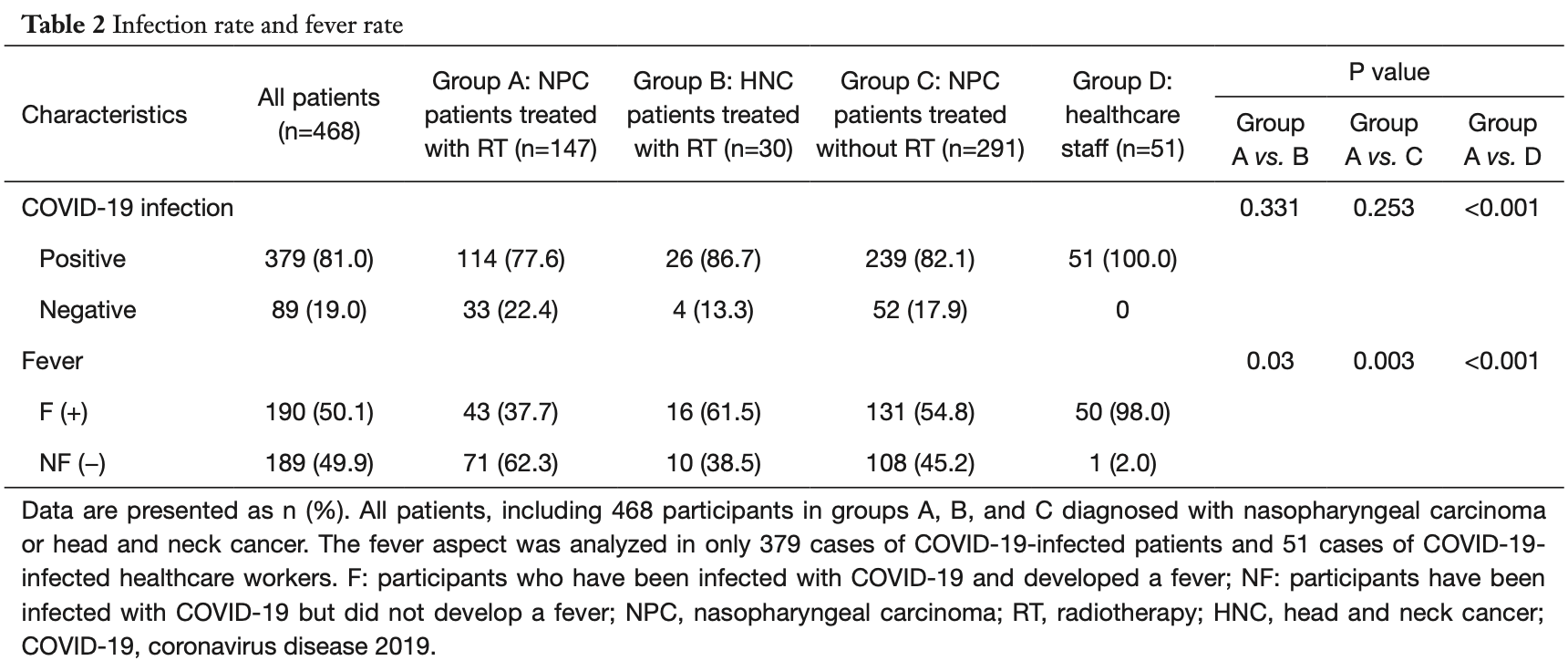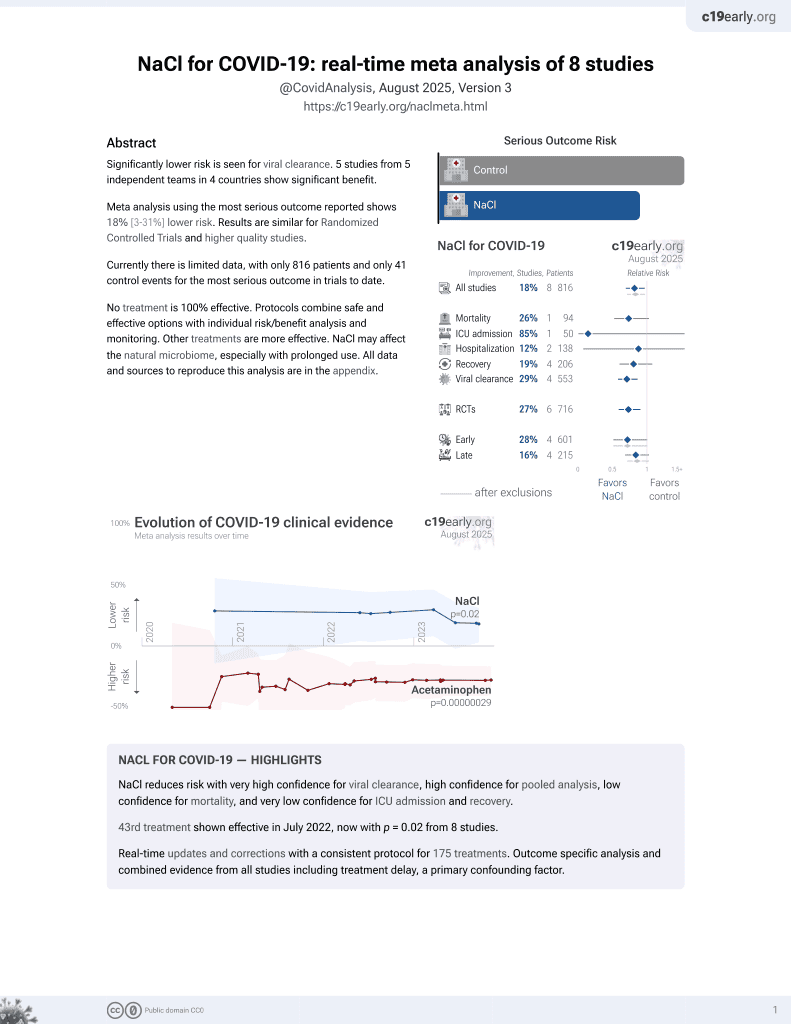
Significance of saline nasalirrigation for COVID-19 infection: observations and reflections from nursing care of nasopharyngeal carcinoma
et al., Translational Cancer Research, doi:10.21037/tcr-23-2384, Feb 2024
NaCl for COVID-19
43rd treatment shown to reduce risk in
July 2022, now with p = 0.0028 from 9 studies.
Lower risk for progression and viral clearance.
No treatment is 100% effective. Protocols
combine treatments.
6,300+ studies for
210+ treatments. c19early.org
|
Retrospective 518 participants (468 cancer patients and 51 healthcare workers) showing reduced fever rate and shorter fever duration with saline nasal irrigation in COVID-19 patients. Among COVID-19 infected patients, those receiving nasal irrigation had lower rates of developing fever and shorter fever duration. No difference was found in COVID-19 infection rates or maximum fever temperatures between groups. The study was conducted during China's Omicron outbreak and included only patients with mild COVID-19, limiting generalizability. Nasal irrigation was only performed by nasopharyngeal carcinoma patients receiving radiotherapy as part of standard care, creating potential confounding. Authors hypothesize that saline irrigation works by reducing viral load through enhanced mucociliary clearance, direct antiviral effects via chloride ions, and anti-inflammatory mechanisms. We compare the NPC groups (A and C) which have similar ages and no significant baseline differences.
Standard of Care (SOC) for COVID-19 in the study country,
China, is average with moderate efficacy for approved treatments1.
|
fever, 35.0% lower, RR 0.65, p = 0.002, treatment 43 of 147 (29.3%), control 131 of 291 (45.0%), NNT 6.3, NPC patients.
|
|
risk of case, 5.6% lower, RR 0.94, p = 0.25, treatment 114 of 147 (77.6%), control 239 of 291 (82.1%), NNT 22, NPC patients.
|
| Effect extraction follows pre-specified rules prioritizing more serious outcomes. Submit updates |
Yan et al., 29 Feb 2024, retrospective, China, peer-reviewed, 9 authors, study period 7 December, 2022 - 7 January, 2023.
Contact: chenlishamd@163.com.
Significance of saline nasalirrigation for COVID-19 infection: observations and reflections from nursing care of nasopharyngeal carcinoma
Translational Cancer Research, doi:10.21037/tcr-23-2384
Background: Coronavirus disease 2019 has placed a tremendous burden on the world's healthcare systems, prompting medical professionals worldwide to diligently research and experiment with treatment methods to prevent infection and alleviate symptoms. Previous studies have shown the potential of nasal irrigation in reducing viral clearance time and alleviating local symptoms of COVID-19. However, views differ regarding its efficacy in improving systemic symptoms. Thus, we sought to examine whether saline nasal irrigation might play a role in treatment and self-care after COVID-19 infection, but further validation is still necessary. Methods: We conducted a retrospective analysis of 468 patients and 51 healthcare personnel concurrently. The participants were grouped based on whether they received saline nasal irrigation. We used χ 2 tests and Fisher's exact tests to assess the differences in the rates of COVID-19 infection and the rates of developing a fever after COVID-19 infection among different groups. Additionally, we used independent samples t-tests and Mann-Whitney U tests to evaluate differences in the maximum fever temperature and fever duration among participants with fever in different groups.
Results: The rate of developing a fever after COVID-19 infection was lower (37.7%) in the patients who underwent saline nasal irrigation. Among all febrile patients, there was no difference in the highest fever temperature, but patients who underwent saline nasal irrigation had a shorter fever duration (1.72±1.05 days). Additionally, the rate of COVID-19 infection and the rate of developing a fever were higher, and fever symptoms were more severe in the healthcare worker group than in the patient group. Conclusions: Saline nasal irrigation can alleviate symptoms caused by COVID-19 infection.
Conflicts of Interest: All authors have completed the ICMJE uniform disclosure form (available at https://tcr.amegroups. com/article/view/10.21037/tcr-23-2384/coif ). M.B.A.M. received a travel grant from Transmedic (Accuray) Philippines to attend the Asia-Pacific Cyberknife users' meeting. The other authors have no conflicts of interest to declare.
Ethical Statement: The authors are accountable for all aspects of the work in ensuring that questions related to the accuracy or integrity of any part of the work are appropriately investigated and resolved. The study was approved by the Ethics Committee of the Fujian Cancer Hospital (No. K2023-207-01) and was conducted in accordance with the Declaration of Helsinki (as revised in 2013). Informed consent was obtained from all participants prior to conducting the follow-up, and for those aged under 18 years, informed consent was obtained from their parents or legal guardians. Open Access Statement: This is an Open Access article distributed in accordance with the Creative Commons Attribution-NonCommercial-NoDerivs 4.0 International License (CC BY-NC-ND 4.0), which permits the noncommercial replication and distribution of the article with the strict proviso that no changes or edits are made and the original work is properly cited (including links to both the formal publication through the relevant DOI and the license). See: https://creativecommons.org/licenses/by-nc-nd/4.0/ .
Cite this article as:
References
Abadie, Mcmains, Weitzel, Irrigation penetration of nasal delivery systems: a cadaver study, Int Forum Allergy Rhinol
Baraniuk, Ali, Yuta, Hypertonic saline nasal provocation stimulates nociceptive nerves, substance P release, and glandular mucous exocytosis in normal humans, Am J Respir Crit Care Med
Batioglu-Karaaltin, Yigit, Cakan, Effect of the povidone iodine, hypertonic alkaline solution and saline nasal lavage on nasopharyngeal viral load in COVID-19, Clin Otolaryngol
Baxter, Schwartz, Johnson, Rapid initiation of nasal saline irrigation to reduce severity in high-risk COVID+ outpatients, Ear Nose Throat J, doi:10.1177/01455613221123737
Bestle, Heindl, Limburg, TMPRSS2 and furin are both essential for proteolytic activation of SARS-CoV-2 in human airway cells, Life Sci Alliance
Cegolon, Mastrangelo, Bellizzi, Supporting the Aspecific Physiological Defenses of Upper Airways against Emerging SARS-CoV-2 Variants, Pathogens
Cegolon, Mastrangelo, Emanuelli, Early Negativization of SARS-CoV-2 Infection by Nasal Spray of Seawater plus Additives: The RENAISSANCE Open-Label Controlled Clinical Trial, Pharmaceutics
Chalageri, Bhushan, Saraswathi, Impact of Steam Inhalation, Saline Gargling, and Povidone-Iodine Gargling on Clinical Outcome of COVID-19 Patients in Bengaluru, Karnataka: A Randomized Control Trial, Indian J Community Med
Chua, Sham, Kwong, Treatment outcome after radiotherapy alone for patients with Stage I-II nasopharyngeal carcinoma, Cancer
Fabbris, Cestaro, Menegaldo, Is oro/ nasopharyngeal swab for SARS-CoV-2 detection a safe procedure? Complications observed among a case series of 4876 consecutive swabs, Am J Otolaryngol
Fahy, Dickey, Airway mucus function and dysfunction, N Engl J Med
Fu, Tong, Meng, Ciliostasis of airway epithelial cells facilitates influenza A virus infection, Vet Res
Georgitis, Nasal hyperthermia and simple irrigation for perennial rhinitis. Changes in inflammatory mediators, Chest
Graham, Burrell, Douglas, Adverse effects of aspirin, acetaminophen, and ibuprofen on immune function, viral shedding, and clinical status in rhinovirus-infected volunteers, J Infect Dis
Hauptman, Ryan, The effect of saline solutions on nasal patency and mucociliary clearance in rhinosinusitis patients, Otolaryngol Head Neck Surg
Hendley, Gwaltney, Viral titers in nasal lining fluid compared to viral titers in nasal washes during experimental rhinovirus infection, J Clin Virol
Heyder, Deposition of inhaled particles in the human respiratory tract and consequences for regional targeting in respiratory drug delivery, Proc Am Thorac Soc
Huang, Wang, Li, Clinical features of patients infected with 2019 novel coronavirus in Wuhan, China, Lancet
Huijghebaert, Hoste, Vanham, Essentials in saline pharmacology for nasal or respiratory hygiene in times of COVID-19 [published correction appears in, Eur J Clin Pharmacol
Huijghebaert, Parviz, Rabago, Saline nasal irrigation and gargling in COVID-19: a multidisciplinary review of effects on viral load, mucosal dynamics, and patient outcomes, Front Public Health
Khailany, Safdar, Ozaslan, Genomic characterization of a novel SARS-CoV-2, Gene Rep
Lieleg, Vladescu, Ribbeck, Characterization of particle translocation through mucin hydrogels, Biophys J
Liu, Wang, Xie, Effect of Nasal Irrigation in Children With Omicron Variant of COVID-19 Infection, Ear Nose Throat J, doi:10.1177/01455613231172337
Liu, Xie, Li, Effect of nasal irrigation in adults infected with Omicron variant of COVID-19: A quasiexperimental study, Front Public Health
Luo, Fu, Cheng, Clinical observation and quality of life in terms of nasal sinusitis after © Translational Cancer Research. All rights reserved, Transl Cancer Res, doi:10.21037/tcr-23-2384radiotherapyfor
Machado, Glaser, Araujo, Inhibition of Severe Acute Respiratory Syndrome Coronavirus 2 Replication by Hypertonic Saline Solution in Lung and Kidney Epithelial Cells, ACS Pharmacol Transl Sci
Middleton, Geddes, Effect of amiloride and saline on nasal mucociliary clearance and potential difference in cystic fibrosis and normal subjects, Thorax
Mozzanica, Preti, Bandi, Effect of surgery, delivery device and head position on sinus irrigant penetration in a cadaver model, J Laryngol Otol
Nikolaou, Mitsi, Ferreira, Assessing the ideal microwave duration for disinfection of sinus irrigation bottles-A quantitative study, Clin Otolaryngol
Nimsakul, Ruxrungtham, Chusakul, Does Heating up Saline for Nasal Irrigation Improve Mucociliary Function in Chronic Rhinosinusitis?, Am J Rhinol Allergy
Pantazopoulos, Chalkias, Miziou, A Hypertonic Seawater Nasal Irrigation Solution Containing Algal and Herbal Natural Ingredients Reduces Viral Load and SARS-CoV-2 Detection Time in the Nasal Cavity, J Pers Med
Park, Choi, Kim, Clinical Practice Guideline: Nasal Irrigation for Chronic Rhinosinusitis in Adults, Clin Exp Otorhinolaryngol
Ramalingam, Cai, Wong, Antiviral innate immune response in non-myeloid cells is augmented by chloride ions via an increase in intracellular hypochlorous acid levels, Sci Rep
Ramalingam, Graham, Dove, A pilot, open labelled, randomised controlled trial of hypertonic saline nasal irrigation and gargling for the common cold, Sci Rep
Rengasamy, Zhuang, Niezgoda, A comparison of total inward leakage measured using sodium chloride (NaCl) and corn oil aerosol methods for air-purifying respirators, J Occup Environ Hyg
Slapak, Skoupá, Strnad, Efficacy of isotonic nasal wash (seawater) in the treatment and prevention of rhinitis in children, Arch Otolaryngol Head Neck Surg
Talbot, Herr, Parsons, Mucociliary clearance and buffered hypertonic saline solution, Laryngoscope
Van Doremalen, Bushmaker, Morris, Aerosol and Surface Stability of SARS-CoV-2 as Compared with SARS-CoV-1, N Engl J Med
Wolf, Koidl, Pelzmann, Regeneration of the ciliary beat of human ciliated cells, Laryngorhinootologie
Xia, Zhao, Shah, Composition, Clinical Efficiency, and Mechanism of NHC-Approved "Three Chinese Medicines and Three Chinese Recipes" for COVID-19 Treatment, Front Pharmacol
Xiang, Fa-Ya, Ping, Management of radiation-induced early nasal adhesion after radiotherapy for nasopharyngeal carcinoma, Am J Rhinol Allergy
Zou, Ruan, Huang, SARS-CoV-2 Viral Load in Upper Respiratory Specimens of Infected Patients, N Engl J Med
DOI record:
{
"DOI": "10.21037/tcr-23-2384",
"ISSN": [
"2218-676X",
"2219-6803"
],
"URL": "http://dx.doi.org/10.21037/tcr-23-2384",
"author": [
{
"affiliation": [],
"family": "Yan",
"given": "Linghui",
"sequence": "first"
},
{
"affiliation": [],
"family": "Ding",
"given": "Jianming",
"sequence": "additional"
},
{
"affiliation": [],
"family": "Xu",
"given": "Mengting",
"sequence": "additional"
},
{
"affiliation": [],
"family": "Lin",
"given": "Xiaoting",
"sequence": "additional"
},
{
"affiliation": [],
"family": "Mejia",
"given": "Michael Benedict A.",
"sequence": "additional"
},
{
"affiliation": [],
"family": "Chen",
"given": "Jiawei",
"sequence": "additional"
},
{
"affiliation": [],
"family": "Xu",
"given": "Yiying",
"sequence": "additional"
},
{
"affiliation": [],
"family": "Hong",
"given": "Huiling",
"sequence": "additional"
},
{
"affiliation": [],
"family": "Chen",
"given": "Lisha",
"sequence": "additional"
}
],
"container-title": "Translational Cancer Research",
"container-title-short": "Transl Cancer Res",
"content-domain": {
"crossmark-restriction": false,
"domain": [
"amegroups.com"
]
},
"created": {
"date-parts": [
[
2024,
2,
29
]
],
"date-time": "2024-02-29T06:12:37Z",
"timestamp": 1709187157000
},
"deposited": {
"date-parts": [
[
2024,
2,
29
]
],
"date-time": "2024-02-29T06:13:42Z",
"timestamp": 1709187222000
},
"indexed": {
"date-parts": [
[
2025,
8,
21
]
],
"date-time": "2025-08-21T17:53:53Z",
"timestamp": 1755798833211
},
"is-referenced-by-count": 2,
"issue": "2",
"issued": {
"date-parts": [
[
2024,
2
]
]
},
"journal-issue": {
"issue": "2",
"published-online": {
"date-parts": [
[
2024,
2
]
]
},
"published-print": {
"date-parts": [
[
2024,
2
]
]
}
},
"link": [
{
"URL": "https://tcr.amegroups.com/article/download/83679/pdf",
"content-type": "unspecified",
"content-version": "vor",
"intended-application": "similarity-checking"
}
],
"member": "8611",
"original-title": [],
"page": "1114-1124",
"prefix": "10.21037",
"published": {
"date-parts": [
[
2024,
2
]
]
},
"published-online": {
"date-parts": [
[
2024,
2
]
]
},
"published-print": {
"date-parts": [
[
2024,
2
]
]
},
"publisher": "AME Publishing Company",
"reference-count": 0,
"references-count": 0,
"relation": {},
"resource": {
"primary": {
"URL": "https://tcr.amegroups.com/article/view/83679/html"
}
},
"score": 1,
"short-title": [],
"source": "Crossref",
"subject": [],
"subtitle": [],
"title": "Significance of saline nasalirrigation for COVID-19 infection: observations and reflections from nursing care of nasopharyngeal carcinoma",
"type": "journal-article",
"update-policy": "http://dx.doi.org/10.21037/ame_crossmark_policy",
"volume": "13"
}
